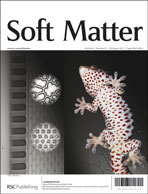Cryostructuring of polymer systems. Wide pore poly(vinyl alcohol) cryogels prepared using a combination of liquid–liquid phase separation and cryotropic gel-formation processes†
Abstract
Novel, previously unknown, wide pore poly(vinyl alcohol) cryogels (PVACGs) have been prepared through a cryotropic gelation approach when water–PVA–gum arabic (GuAr) ternary liquid systems were used as feeds. The following set of conditions necessary for obtaining wide-porous, permeable for a water flow, and, simultaneously, mechanically strong enough PVACGs was established: the total concentration of gelling component—PVA (MW of 86 kDa) and non-gelling polymer—GuAr (MW of ∼650 kDa) should exceed ∼14 wt%, the GuAr : PVA ratio should be near 1 : 1 (w/w), and the feed pH should be within the range of ∼5 to 11. The phase diagrams for the water–PVA–GuAr ternary liquid systems at pH 5.3 and 10.0 have demonstrated that such “optimum” compositions are in the vicinity of the rectilinear diameters of the respective diagrams, and that the limit of GuAr solubility in the PVA-rich phase is small. In such cases this GuAr fraction strongly binds with PVA, especially under alkaline conditions, within the gel forming phase of heterophase PVACG. Light microscopy studies revealed the presence of at least three distinct kinds of pores in these cryogels. First, there are interconnected channel-like gross pores with a cross-section of 100–200 μm and larger which are the replicas of continuous GuAr-rich phase in the two-phase polymeric systems appearing due to the liquid–liquid phase separation in the ternary water–PVA–GuAr system. The second type are isolated roundish large pores ca. 10–70 μm in diameter being the replicas of the GuAr-rich phase dispersed as liquid droplets in the PVA-rich phase. In the third, there are smaller rounded pores ∼1 to 5 μm in diameter being the replicas of ice polycrystals. Such a sophisticated “poly-porous” morphology of the studied PVA cryogels is their unique feature distinguishing them from other known PVA cryogels.


 Please wait while we load your content...
Please wait while we load your content...